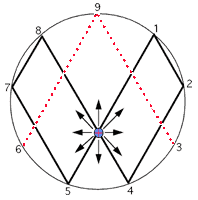excreationist
Married mouth-breather
I'm giving up on what you were responding to back there - after all I was in a mental ward at the time. Though I think I'm onto something with the numbers and 4 Playstation symbols, etc.No, and i don't gotta.
You've got 9 elements, with 8 filled in, but no points to say THIS is how the figure must be drawn. And for the 5, some points are on filled in squares, some are on blank elements OR squeezed into a shared element. So you have to fudge to get results, anyway.
Not terribly useful, fudged systems, because you only get dependable answers if you know where to cheat.
No it does not.7 point geometry means octal
1110000
1001100
1000011
0100110
0101001
0010101
0011010
...with no two iterations having more than a single set bit in overlap.
kinda my point...and the circle doesn't really have points?
Have you actually tried though? It involves every single combination of fingers being up and down. I am unable to have the little finger/pinky down with the others up. I'm sure large numbers of people have the same problem.Also, i can count to 1023 on my fingers, a fact i have demonstrated for each child's girlfriend, just to mortify them (the boys, not the girlfriends].
Last edited:



